Cuba Libre?
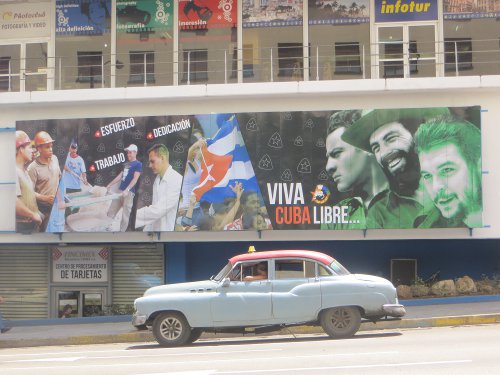
During our time in Cuba, we had daily talks regarding Cuban routine life, their political system, history, and the people’s welfare. We found ourselves debating on the pros and cons of Cuban life and overall we felt very confused about it. What we saw, heard from locals, read in museums, and experienced in Cuba motivated the following reflections. While reading please keep in mind that one month in Cuba as tourists will never equal the day-by-day and year-after-year living experience of the Cuban people. Our thoughts are not meant to be the absolute truth but rather the views of two outsiders who have always lived in capitalist and democratic societies trying to put themselves in other people’s reality.
Before our arrival to Cuba we were full of excitement. Many details of the Cuban experience fed to the daily joy of finally being there: the smile and warm “welcome to Cuba” from the immigration officer, the lack of traffic and the streets always full of pedestrians finding their way, the dismantled buildings screaming out for an end to the over 50-year US trade embargo on the island, the fraternity of locals once they found out we were from Latin American countries, the minimum use of plastic and non-degrading trash products by locals, and the emblematic and colorful classic cars driving by that was a tempting attempt for a perfect picture. We were in a country where the appearance of old or damaged material items did not matter and where education and health care are completely free and accessible to all Cubans, which we believe, is much more important than having the ability to get in debt to purchase a new car or clothes. Important social policies, such as equal pay for men and women, paid maternity or paternity leave for the first year of their child’s life, and free child care for children of working mothers are available. Food for each Cuban is guaranteed and given at a very low monthly cost and the government food distribution takes into account special diets due to medical need or developmental stages for children. We did not meet any Cuban without a place to live, most families own their homes, and the government had construction projects that give Cubans access to new houses at a low monthly cost. Racism and discrimination are not only illegal, but you see all Cubans integrated, interacting with respect and fraternity regardless of the color of their skin. Nobody appeared to be wealthier or more privileged than others; only a few people came to us asking for money in a clear attempt of trying to take advantage of tourists. We never saw children begging in the streets or homeless, instead they were playing freely. Incidents of violence and crime in Cuba are amongst the lowest in Latin America and the country felt very safe. We walked day and night without facing risk or fear of violence. Guns are illegal to the general public and allowed only for police and military. Drugs are also illegal and their use is uncommon. Cuban’s are ecological by necessity. In 2006, the World Wide Fund for Nature (WWF) named Cuba as the only country in the world with sustainable development based on the human welfare index (life expectancy, literacy, and GDP) and the ecological footprint (the amount of land needed to fulfill a person’s food and energy needs). Cuba’s living cost is very low, for example a ride in a public bus within Havana costs less than 2 cents USD per person and having a good size lunch for 30 Cuban pesos, sometimes even less, which is just a little over $1 USD, is possible if you look for the small cafeterias or government restaurants where locals eat. Even more unbelievable, a box with six condoms only costs 1 Cuban peso which is 4 cents USD. Although government salaries are very low, a national average of $20 USD per month, $8 USD for a waiter, $40 USD for a doctor or an engineer, the basics are being provided, but understandably Cubans wish they could have more money in their pockets. Furthermore, the last few years, opportunities to start private businesses or work independently became real and many Cubans are now working this way. Despite Cuba’s financial challenges, this nation has been admired for doing fantastic things abroad and helping other nations: Cuba sends medical doctors to countries in need all over the world, including the US after the devastating Katrina hurricane; Cubans are highly distinguished in the Olympic Games and their athletes have obtained several medals; Cuba gives free university education to many international students; Cuba has helped many countries to fight for their liberation; and in the last years Cuba, with Norway’s assistance, has been hosting and assisting the peace conversations between the Colombian government and the FARC guerrillas to help end a war of over 50 years.
So what makes a country free? Democratic or dictatorial? Poor or rich? The equality and well-being of all the citizens or the huge gap amongst those who have and have not? The sense of liberty to vote for their leaders who regardless of being chosen by the majority of the people often make decisions to benefit a few bankers or the trust in leaders that continue putting the welfare of the majority as a priority? This is a complicated dilemma to answer and we have never lived in a communist or socialist society to give a fair answer. Although we cannot truly judge what system, capitalist or communist, is best, we think most likely neither of these can completely meet the needs and desires of all individuals. We have witnessed extreme poverty and homelessness in capitalist societies, and we have also seen the lack of freedom and strong government censure in communist societies. We wish everyone could enjoy the liberty to vote and profit but also the security of the basic essentials to live, such as shelter, food, health care, and education. Maybe the system we are wishing for is Democratic Socialism!
We made it to Cuba a few days after the US president, Barack Obama, visited the island, a historic event considering the decades of broken relations between both countries. This visit was an important gesture in the process of re-establishing political relations and many Cubans expressed hope that this event would bring improvement to their economy. During his visit, Obama expressed interest in helping the Cuban people, he wishes for the liberties of democracy. A US journalist asked directly about the “Cuban political prisoners” to the Cuban leader, Raul Castro, who denied they exist. The Cuban government has been explicit about their conditions to work in their diplomatic relationship with the US, requesting the end of the embargo and the removal of the Guantanamo US military base from their territory. The former Commander in Chief, Fidel Castro, communicated with the people of Cuba after Obama’s visit reassuring that Cuba does not need anything from the US.
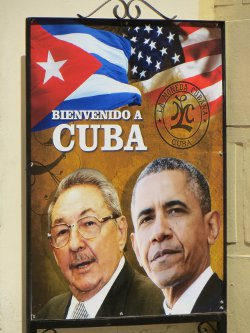
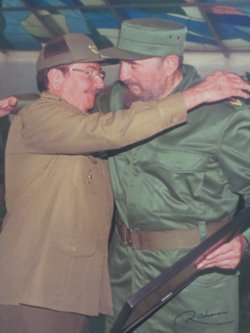
While we were in the country, we saw a lot of Cuban and US flags displayed together, but when we inquired further about the topic we received different answers. Some Cubans expressed feeling uncertain about democracy because they do not know if it could be positive for their country. They trust their communist party, mistrust the US government intentions, and do not want to risk the social conquests attained thanks to the revolution. Other Cubans said they feel confused about “becoming friends with the Yankees” after everything that happened and their huge ideological differences. Some also said they were fearful of how unprepared Cuban society is to the resist the impact of capitalism and at the same time open to acknowledge their unhappiness regarding their low salaries and desire to vote for the first time for a Cuban President.
Other Cubans who have been able to travel abroad and see the realities of other countries say they are aware of the multiple problems Cuba has, but value the peace and safety their country offers more than anything. Other Cubans expressed feeling completely frustrated with their political system, lack of freedom of speech, the corruption amongst government employees, the low salaries, economic limitations to buy things and travel, sympathy toward capitalism, and hungry for democracy so they could vote. Those Cubans tired of corruption explained that government employees take advantage of their jobs to steal products like gasoline or cooking oil and sell them at a lower price in the black market. People emphasized that this corruption has been motivated by the low salaries they earn. They also explained that although health care is free, services do not work well and hospitals are often without supplies, medicines, and unclean. In addition, some Cubans complained that social services like free childcare have long waiting lists and many mothers end paying someone to take care of their children so they can return to work
The history of Cuba is characterized by the ideas and leadership of many men and women who fought for liberty and equality. Cuba was one of the first territories where Christopher Columbus disembarked in the Americas in 1492 and the last one to be liberated from Spain. From an early age, Jose Julian Marti Perez (1853 – 1895) was a revolutionary example of what needed to change in the island. He was a writer and a fighter during the times in which Cuba was still under the domination of the Spanish colony and slavery was practiced. After being in prison for acting against the Spanish colony, Marti left Cuba and distinguished himself as a diplomat. While being in exile, Marti united forces to fight the Spanish regime and came back by boat into the eastside of the island to begin the liberation movement. Marti died in the attempt and became Cuban’s national hero and symbol of independence. This independence was not reached until 1898 and quickly followed by a neo-colonial period, marked by the US government intrusion and economic control. After Marti, many other leaders followed and died in their wish to attain a Cuba Libre, where benefiting a foreign government or a few wealthy Cuban families was not the priority, where children do not die from malnutrition, where farmers are not cheap labor for the rich land owners, and all citizens could read and write. Fidel Castro with many other revolutionaries of his generation began the guerrilla movement against the dictatorship regime of Fulgencio Bastista by attacking the Moncada Fort in Santiago de Cuba in July 26, 1953. Fidel was arrested and sentenced to many years of imprisonment, but let free earlier, an opportunity he took to leave Cuba and avoid being assassinated like many other leaders. And just like Marti did in his time, Fidel united forces during his exile in Mexico and returned by boat to the eastside of the island on December 2, 1956 to continue the liberation. Fidel Castro with the help of others, including the legendary Ernesto Che Guevara, began to fight from the mountains of La Sierra Maestra, a spectacular place we were fortunate to visit. After the victory of the Cuban revolution on January 1, 1959, the dictatorship of Batista ended as he escaped towards the Dominican Republic. Years of internal conflict and war between the revolutionaries and the so called “Bandidos” or “Anti-revolutionaries,” which Cubans accused the US government of supporting, followed and did not end until 1966. Fidel Castro, who is appreciated, admired, and respected by many in Cuba and around the world, is also hated and criticized by many others as well, is about to turn 90 years old on August 13, 2016. Fidel is not only the main leader of the Cuban Revolution but as a tobacco farmer in Viñales told us: “Fidel Castro is the greatest man, thanks to him the famine and hardship our people endured during Batista’s dictatorship ended, and he gave us back the land. The land is now for the people that work it.”
The social changes were significant in the beginning of the revolution, unemployment decreased from 657,000 to 214,000 in the period of 1958 to 1962. Different policies like the nationalization of several industries, confiscation of properties and assignment of houses to previous renters, and the Agrarian Reform to redistribute the land fairly made a difference in the lives of Cubans. Illiteracy was almost abolished in a one year period, 707,212 individuals learned to read and write. However, concerns regarding civil right violations have been raised through the years as the Cuban communist government refused to respect people’s rights to assembly, associate, and express their criticism regarding their politics. The political system ruling the country is compared with a “dictatorship” because Cubans do not get to vote for their president.
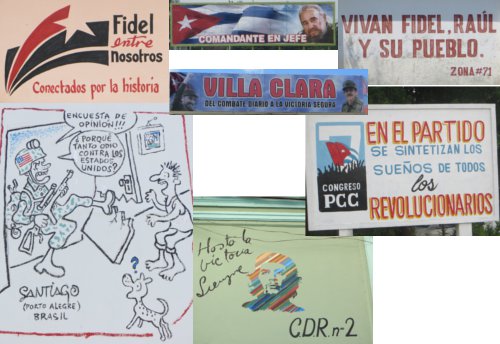
We learned that Cuban citizens meet and elect delegates in their Committees in Defense of the Revolution (CDR), which are formed by neighbors living in the same block and are at a very low level of hierarchy. The CDR’s were created by Fidel Castro in September 28, 1960 to prevent more anti-revolutionary movements and violent attacks by having neighborhoods watching over each other and all Cuban civilians working together. Young Cubans can also participate in communist groups. The biggest participation could be to become a member of the Cuban Communist Party. Besides what is stated above, Cubans are only left with watching the congress discussions on television which takes place every 5 years. We were able to watch some speeches from Raul and Fidel Castro on television during the 7th congressional meeting as it coincided with our time in Cuba and we were impressed with the organization and level of self-criticism regarding their political goals. Although the right to protest is censored and punished, Cubans told us that, technically, they can express concerns at their CDR monthly meetings but they know they cannot say everything they feel. The contradicting part about prohibiting people to protest and express different ideas is that it denies Cubans the same right that allowed them to change so many injustices from the past. Why would revolutionary leaders prohibit or punish their people for questioning or disagreeing? Why a government that educates their people would not allow them to speak up? All over Cuba we noticed a strong effort to build up patriotism and remembrance of their history. In Camaguey, we heard kids with the age of 5 and 6 already talking about their national symbols and heroes. In Santiago de Cuba, we saw big monuments and well-kept museums while people’s houses are falling apart. Although having a sense of belonging and knowledge of their history are extremely important, we wonder how much emphasizing on it becomes a way of propaganda and indoctrination.
Despite the efforts, policies, and dirty attempts of the US government to sabotage and debilitate the Cuban communist movement and take back control of the island, Cubans persisted. While we were in Cuba, they proudly celebrated the 55th anniversary of their victory against the US invasion in Playa Giron in April 19, 1961, better known as the Bay of Pigs invasion. During the initial years of Cuban socialism, the country received significant financial support from the Soviet Union until the 90’s when it collapsed. From then on, Cuba faced years of critical economic challenges known as the Special Period, which lasted until 1998. Many desperate Cubans tried to flee to reach Florida by sea in an attempt of getting US legal amnesty and protection, but many died along the way. In Bayamo, we were heartbroken while listening to the memories of a family during those difficult years: no electricity to cook or light at night, no water or soap to shower or wash clothes, not much food to eat, no new clothes or shoes to wear, no fuel or cars for transport, and no salaries. Cooking with wood in a communal way and sharing food with your neighbors, going to work without knowing if you will get paid or will have something to eat for lunch, making sandals with leftover rubber from tires, studying under the light of a candle, and washing clothes with ashes became the solutions during that period.
The resiliency and resourcefulness of the Cuban people and their ability to stay united to overcome those challenging years is something we admired. Could you imagine how far Cubans could reach with the proper resources? Without the financial burden of a brutal US embargo to a socialist island that is floating alone in an ocean of capitalism. The last few years Cuba has seen changes in their economic strategies and most Cubans are welcoming them with hope. The creation of private businesses like home stay services for tourist, restaurants, and stores are increasing. Home stays for example, must pay the government a fixed monthly contribution plus 10% of their earnings, but individuals are allowed to profit. Many families have embarked into this new business venture, borrowing money to build or remodel their properties, which is a huge effort given their low income, but it has been worth it.
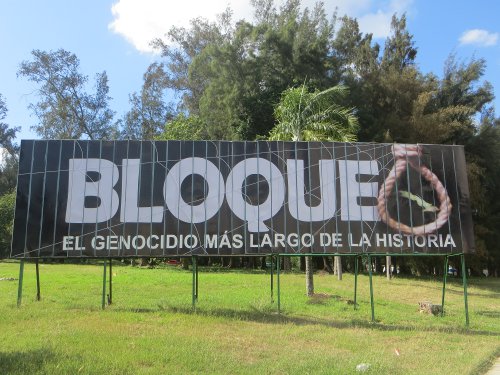
Many Cubans are now working independently or for private businesses, although these jobs pay better they usually require long working hours: 11, 12 or even 14 hours straight, which we cannot understand why it is being allowed. Cubans are now also free to sell their houses and cars, “for sale” signs are everywhere. We heard many stories of Cubans that have sold their homes and left the country, many of them are now stuck in Central America, still trying to reach their “American Dream.”
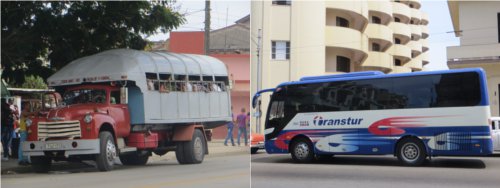
With the increase of tourism and the new economic policies, evident differences in prices and quality of services now exist on the island. The coexistence of socialism and capitalism is complex and sometimes conflicting. Two currencies are been used in Cuba: Cuban Pesos – CUP and Cuban Convertible – CUC, 1 CUC equals 25 CUP and $1 USD. Tourists can buy things and visit places in Cuba that are financially inaccessible for most Cubans, and many locals verbalized feeling frustrated and sad about it.
We wonder how much longer socialism will be able to stay in charge without losing the spirit. We worry that Cuba could be like China, a communist country only by name. We hear locals talking about the things they want but cannot have: everything tourists get to do, see, and even eat in their own land but they cannot afford. The famous slogan “Patria o Muerte” (Homeland or Death) that united Cubans during the worst times sounds meaningless when foreigners get to enjoy the nation they sacrificed for. There is also a significant income gap between Cubans that work in tourism and the rest. If working in tourism is much more profitable than being a professional, would the new generations still care to go to university? From the huge social gap that is taking place in Cuba now, we really dislike the different access to transportation that exists for locals and tourist: while foreigners get to travel comfortably sitting in A/C buses, which are expensive and most Cubans cannot afford, many locals do not have another option than to take “camiones,” metal vehicles used to transport cows and now slightly altered for people, which are always full, stand up room only, and without much ventilation; they look like sardines in a can. Why would the socialist government of Cuba allow this unfairness with their own people? Is capitalism already ruling the island? While we were in Havana, we noticed a strong effort of restoration and construction in the tourist areas, most likely to maintain the steady wave of tourism as it has become an important income for Cuba. Although we understand money needs to be spent this way, we could not help to feel sad while seeing the neighborhoods where Cubans live are falling apart. It felt like a betrayal to the purpose of the revolution to see these neighborhoods. It seems as once again capitalism has won over the needs of the people. The money is being spent for pleasing the eyes of tourists rather than the direct needs of the Cubans, because it is of critical importance to guarantee jobs and more money coming into the country. Some Cubans complained about the strong control the Cuban government has even over the salaries of Cuban doctors, engineers, or construction employees working for international companies or a foreign government in Cuba or abroad. The Cuban government does not allow these foreign companies or governments to directly pay high salaries in foreign currency to Cuban workers. The Cuban government obligates foreign companies and governments to pay the Cuban government for the jobs these Cubans do and later they pay them much less. Will Cuba become a source of cheap labor like China? Something we also disliked about Cuba’s reality is how common sex tourism and prostitution are. We heard about several older men from Canada, Germany, and Italy coming to have romantic relationships with much younger Cuban women and these women engaging in these relationships with foreigners to get financial support while maintaining a parallel relationship with their local partner. A local was telling us that “Cuban women are the cheapest in the world,” he proceeded to tell us that they prostitute themselves for $10 or even $5 USD and although prostitution is illegal in Cuba it keeps happening.
More than anything what Cubans wish for are higher salaries to be able to travel inside their country and abroad and to be able to elect their president. When we talked to them about the social realities of other nations, including Latin America and the US, Cubans verbalized how much they do value the social guarantees and peacefulness of their nation. Freedom is a complex concept. In a world governed by capitalism and the interest of the US, Cuba’s economic development and freedom has been held back for decades. Furthermore, despite how important, fair, and necessary socialist principals are, each individual has their own sense of freedom that, unfortunately, is often attached to their own personal dreams and not to the welfare of the communities to which they belong. Individualist and materialistic tendencies are heavily nurtured by most westernized societies and very often we want what we have not had. We saw those tendencies reflected in Cuban attitudes and interests who now struggle to value what they do have and instead focus on the material things they want to attain. After our month in Cuba, we worry about the future of their socialism and people’s ability to stay true to those principals. The tendencies we saw and the increasing social gap between Cubans themselves, made us think that the future of Cuba’s communism could be as fake as China’s is today. We also think it is necessary for the US government to stop interfering and sabotaging with Cuba’s economy and to finally put an end to the embargo and respect their sovereignty by removing the US military base from Guantanamo. We really hope Cubans can continue to progress in their goals of maintaining social welfare and equality while they keep opening opportunities for individuals to reach their potential and dreams. We wish for a Cuba where not only the nation is politically and economically free, and independent from other oppressive countries, but also where their individuals can be free to choose, speak up, protest, and elect their president. As Jose Marti wisely wrote: “The Republic should not be the unfair control of some citizens over the rest, but the open and honest equilibrium of all the real forces of the country, of the thoughts and free wishes of all the citizens.” Cuba Libre! Hasta la Victoria Siempre!
